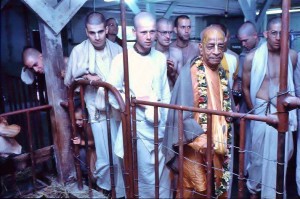Here are the notes I’ve prepared for speaking to a gathering of serious practitioners of bhakti-yoga on Gaura-Pūrṇimā …the anniversary celebrating the appearance of the Golden Avatāra, Śrī Krishna Caitanya.
Gaura Pūrṇimā
The 4th, 5th, and 6th ślokas of Caitanya Caritāmṛta explain the reasons why Śrī Krishna and Śrī Krishna Caitanya appear in our world. The author of Cc, Śrīla Krishnadāsa Kavirāja, organizes these reasons into two groups: bahirāṇga-hetu and antarāṅga-hetu. This is often translated as “external” and “internal” reasons. “External” means “for the sake of other people,” and “internal” means “for his own sake.” So there are two groups of reasons for the avatāra of Śrī Krishna and Śrī Krishna Caitanya: reasons that benefit other people, and reasons that benefit himself. I will call these the “public motives” and “private motives” of these avatāra.
The 4th śloka explains their public motives. The 6th explains their private motives. And the 5th is important to both, because it explains how Śrī Krishna Caitanya accomplished the motives initiated many centuries earlier by Śrī Krishna.
Ādi 1.4
Quoted from Vidagdha-mādhava of Śrī Rūpa Goswāmī
anarpita-carīḿ cirāt karuṇayāvatīrṇaḥ kalau
samarpayitum unnatojjvala-rasāḿ sva-bhakti-śriyam
hariḥ puraṭa-sundara-dyuti-kadamba-sandīpitaḥ
sadā hṛdaya-kandare sphuratu vaḥ śacī-nandanaḥ
anarpita-carīṁ — No one made any attempt to give it
cirāt — For a very long time ago
therefore
karuṇayā — because of sympathy / compassion / kindness
avatīrṇa — he descends (avatāra)
kalau — in the age of Kali
what is it that has not been available for such a long time?
śriyam — a treasure …what kind?
sva-bhakti śriyam – the treasure of his own love
…this is the most important treasure because love is the only wealth that actually makes us happy, and “his own” love is divine love which is the only thing that can make us perfectly and totally happy.
…but what kind of love has not been available for a long time? Hasn’t divine love always been available?
ujjvala-rasā — the most beautiful, brilliant, intimate form of love – romantic love.
…hasn’t this also been available? i.e. Lakṣmī, Sītā, etc.?
unnata-ujjvala-rasā — the most exalted form of romantic love. (i.e. Vṛndāvana bhakti < gopī-bhakti < and even the love of Krishna that Śrīmatī Rādhārāṇī herself experiences)
samarpayitum — he is not going to give just a little hint of it, but all of it, completely.
who is he? who is qualified to give what no one else has given?
hari — he is Hari, …but not black, not dark…
sandīpita — he is illuminated and bright
sundara-dyuti — with effulgent beauty …what color?
puraṭa / kadamba — the color of gold and kadamba flowers. (Śrīmatī Rādhārāṇī’s color)
Who is this golden avatāra of Hari?
śaci-nandana — Śaci’s son, Gaura-hari, Śrī Krishna Caitanya.
Śrī Rūpa then gives a benediction:
hṛdaya-kandare — in the hidden chambers of our innermost heart
sphuratu — may he suddenly appear
sadā — forever!
Śrīla Prabhupāda has given us this beautiful translation:
May the Supreme Lord who is known as the son of Śrīmatī Śacī-devī be transcendentally situated in the innermost core of your heart. Resplendent with the radiance of molten gold, He has descended in the Age of Kali by His causeless mercy to bestow what no incarnation has ever offered before: the most elevated mellow of devotional service, the mellow of conjugal love.
Krishnadas Kaviraja explains what this verse means (Cc Ādi 3.5-31). He says,
Krishna forever enjoys bliss in the transcendental realm of Vrndavana, but every once in a while Vrndavana descends into our mundane realm. “Every once in a while” means once in every universal day – which means once every 8 billion years. Vṛndāvana descends into this world so that we can get a glimpse of real joy, real love – infinitely perfected in Krishna’s relationships with the inhabitants of Vrndavana. This happened fairly recently, about 5,000 years ago. That is why we currently know about Krishna.
Krishnadāsa Kavirāja explains Krishna’s motive for appearing in this world (Adi 4.14-35):
aiśvarya-jñānete saba jagat miśrita
aiśvarya-śithila-preme nahi mora prīta
“The whole world is full of awareness of my power, but love that is weakened by a sense of power does not please me.
As long as someone thinks of me as The Master their love cannot overpower me. But I want to taste the joy of being overpowered by love. I want my mother to protect me and chastise me. I want my friends to wrestle and race me, and say, ‘You’re not such a big man!’ I want to have to beg for the mercy of my lover! No religion or philosophy can thrill me as much as this!
I will take these devotees with me – my parents, my friends, and my lovers – and make them appear within the vision of the mortal world. We will display such unbridled, unrestricted pure love that cannot be found even in Vaikuntha and which amazes even me!
I will especially display my intimate romance with the gopīs, because this is the epitome of the unrestricted love that I crave, and that conquers my heart. This will bring me great joy, and will also benedict the whole world, because it will attract them to the supreme joy of the greatest love!
vrajera nirmala rāga śuni’ bhakta-gaṇa
rāga-mārge bhaje yena chāḍi’ dharma-karma
When my devotees hear about the pure and passionate love found in Vṛndāvana they will completely abandon the formal love inspired by morality and duty, and cultivate love for me with real, passionate affection – like the Vrajabāsīs!
This is why Krishna appears as an avatāra once every universal day. But after Vṛndāvana disappears from this mundane realm and a few thousand years have passed, Krishna is disappointed about the reaction. Krishnadāsa Kavirāja explains that he thinks:
cira-kāla nāhi kari prema-bhakti dāna
bhakti vinā jagatera nāhi avasthāna
“Even after all this time, people are still not embracing the blissful treasure of divine love. If people cannot experience the happiness of divine love, there is no point in the universe even existing at all!”
One of Krishna’s companions tries to console him. “Don’t worry, people do eventually become religious and worship God.” But Krishna becomes even more upset when he hears this. He says:
sakala jagate more kare vidhi-bhakti
vidhi-bhaktye vraja-bhāva pāite nāhi śakti
“The entire universe might become interested in the rules and regulations of religion – vaidhi-bhakti. But that will never be able to give them what I want to give them: the bliss of the divine love experienced in Vṛndāvana.”
His companion asks, “Why not be satisfied that they can at least attain some sort of divine love?” Krishna replies:
aiśvarya-jñānete saba jagat miśrita
aiśvarya-śithila-preme nāhi mora prīta
“The whole universe looks on me in awe. The kind of love that is polluted by awe is not very blissful, and doesn’t make me very happy.”
He goes on to say:
“No one can enter Vṛndāvana by following rules and regulations and looking upon me in awe. At best they can only hope to enter Vaikuṇṭha and associate with Nārāyaṇa.”
Then Krishna got an amazing idea. He decided to personally return to our mundane realm and show everyone how to attain the amazing blissful divine love of Krishna that shines in the transcendental realm of Vṛndāvana.
yuga-dharma pravartāimu nāma-sańkīrtana
cāri bhāva-bhakti diyā nācāmu bhuvana
“I will personally inaugurate a different religion, one that is beyond rules and regulations – the religion of Nāma Saṅkīrtana – which alone grants access to the intimate divine love available in Vrndavana. I will personally take the world by the hand and make them dance in joy!”
Krishna realized that you cannot effectively preach something you don’t practice. So, since he wanted to show the world how to love Krishna like the residents of Vrndavana, he could not continue to keep the identity of being Krishna. He would instead become a devotee of Krishna, so he could personally demonstrate how to attain ecstatic devotion, by his own example.
By saying that “he is hari with a brilliant golden complexion” a hint has already been given regarding how Krishna can accomplish his goal of spreading pure, unlimited devotion. He has to become a pure, unlimited devotee. The purest, most unlimited of all devotees is Śrīmatī Rādhārāṇī, whose complexion is brilliantly golden. The next śloka, the 5th śloka of Caitanya Caritāmṛta explains this.
Ādi 1.5
Quoted from the Diary of Śrīla Svarūpa Dāmodara Goswāmī
rādhā kṛṣṇa-praṇaya-vikṛtir hlādinī śaktir asmād
ekātmānāv api bhuvi purā deha-bhedaḿ gatau tau
caitanyākhyaḿ prakaṭam adhunā tad-dvayaḿ caikyam āptaḿ
rādhā-bhāva-dyuti-suvalitaḿ naumi kṛṣṇa-svarūpam
Rādhā — Rādhā
Krishna-praṇaya-vikṛti — is a very special creation of Krishna’s passionate love
hlādinī śakti asmāt— she is Krishna’s pleasure potency itself
Line 2
eka-ātmānāu - Rādhā and Krishna are therefore a single being
api — but
deha-bhedam gatau tau — they attain two distinct forms
bhuvi — by manifesting tangibly
purā — since the very beginning
Line 3 (two become one)
adhunā — and now
tad-dvayam — those two
ekyam āptam — become one
prakaṭam caitanya ākhyam — manifesting as the being named Caitanya
Line 4 (Śrī Caitanya is…)
Kṛṣṇa-svarūpa — Krishna himself
suvalita — beautifully enwrapt in…
rādhā-bhāva — Rādhā’s character / Rādhā’s personality…
dyuti —and effulgent complexion.
naumi — “he is my everything.”
Śrīla Prabhupāda’s beautiful translation:
The loving affairs of Śrī Rādhā and Kṛṣṇa are transcendental manifestations of the Lord’s internal pleasure-giving potency. Although Rādhā and Kṛṣṇa are one in Their identity, They separated Themselves eternally. Now these two transcendental identities have again united, in the form of Śrī Kṛṣṇa Caitanya. I bow down to Him, who has manifested Himself with the sentiment and complexion of Śrīmatī Rādhārāṇī although He is Kṛṣṇa Himself.
Śrīla Krishnadāsa Kavirāja explains this verse (Cc. Ādi 4.56-100) by elaborately explaining who Śrīmatī Rādhārāṇī is. If I had the chance I would explain all these verses for Śrīmatī Radharani’s appearance festival. But because it is important to explain the private motive for Śrī Caitanya Mahaprabhu’s appearance and since we are modern people, always rushing to our next appointments and always checking our digital clocks, I have to skip these verses for now.
Ādi 1.6
An Original Composition of Śrīla Krishnadāsa Kavirāja
śrī-rādhāyāḥ praṇaya-mahimā kīdṛśo vānayaivā-
svādyo yenādbhuta-madhurimā kīdṛśo vā madīyaḥ
saukhyaḿ cāsyā mad-anubhavataḥ kīdṛśaḿ veti lobhāt
tad-bhāvāḍhyaḥ samajani śacī-garbha-sindhau harīnduḥ
śrī-rādhāyāḥ praṇaya — Śrī Rādhā’s passionate love for Krishna
mahimā — greatness
kīdṛśa — What is it like?
^ The first personal motive: to discover, “How great is Śrīmatī Rādhārānī’s love for me?”
anaya-eva — certainly no one except her
āsvādya yena — can taste / relish / enjoy that love
adbhuta-madhurimā — amazing sweetness
kīdṛśa — What is it like?
^ The second personal motive: to discover, “What types of amazing sweetness can she alone enjoy as a result of her love for me?”
madīya — from me
mad-anu-bhāvata — my reciprocation with her love
saukhya — happiness
kīdṛśa — What is it like?
^ The third personal motive: to discover, “What happiness does she experience in me and in my loving reciprocation with her?”
veti lobhāt — because of intense desire to know the answers to these three questions
tad-bhāva-āḍhyaḥ — taking her personality / character
samajani — he was born
hari-induḥ — The Hari-moon
śacī-garbha-sindhau — from the ocean of Śacī’s womb.
Śrīla Prabhupāda translates;
Desiring to understand the glory of Rādhārāṇī’s love, the wonderful qualities in Him that She alone relishes through Her love, and the happiness She feels when She realizes the sweetness of His love, the Supreme Lord Hari, richly endowed with Her emotions, appeared from the womb of Śrīmatī Śacī-devī, as the moon appeared from the ocean.
Śrīla Krishnadāsa Kavirāja explains this verse (CC A.4.231-275). First he explains why Krishna so fervently desires to comprehend Śrīmatī Rādhārāṇī’s love for him:
kṛṣṇera vicara eka āchaye antare
pūrṇānanda-pūrṇa-rasa-rūpa kahe more
Once, Krishna thought within himself, “everyone says I am the form of complete bliss and complete joy…”
āmā ha-ite ānandita haya tribhuvana
āmāke ānanda dibe — aiche kon jana
“The three worlds derive bliss from me. But is there anyone who can give bliss to me?”
āmā haite yāra haya śata śata guṇa
sei-jana āhlādite pāre mora mana
“If there was someone who had hundreds and hundreds more qualities than I, that person could bring joy and pleasure to my heart.”
āmā haite guṇī baḍa jagate asambhava
ekali rādhāte tāhā kari anubhava
“In the whole of existence there is no one who has more qualities than I, with the sole exception of Rādhā. I understand that.
“My beauty conquers millions of lust-gods, there is no sweetness of beauty greater than or equal to mine, it gives bliss to all the three worlds… but my own eyes become enchanted when they see Rādhā’s beauty!
“The songs of my flute attract the three worlds, by my own ears are attracted to Rādhā’s voice! My scent fills the universe with fragrance, but the scent of Rādhā’s body takes my breath away and steals my mind! Because of my flavor, the whole world is full of flavor, but I become a slave to the flavor of Rādhā’s lips! My touch is more pleasant than millions of moon beams. But Rādhā’s touch pleases even me!
ei mata anubhava āmāra pratīta
vicāri’ dekhiye yadi, saba viparīta
“So it is easy to understand why I love her, and easy to understand my emotions and feelings. But when I try to understand her emotions and feelings… they seem completely opposite to mine. I become completely satisfied by experiencing her, but she becomes completely hungry by experiencing me!
When the wind blows through the bamboos and makes a sound like my flute, she becomes mad and begins hugging dark trees, thinking that they are me! When the wind somehow carries her a scent that resembles mine, she leaps into the air and tries to fly towards it! I cannot possibly comprehend or even describe the ecstatic bliss that she experiences in me, it makes me forget my own happiness and desire to experience hers!
Now, Krishnadāsa Kavirāja begins to explain that Krishna wants to experience himself through her eyes.
tāte jāni, mote āche kona eka rasa
āmāra mohinī rādhā, tāre kare vaśa
So I can understand that there is some unique flavor in me… which only she can taste… and which is so exquisite that it captivates Rādhā, who captivates me.
Finally the Kavirāja expresses the third desire, that Krishna wants to experience what she experiences in his love for her.
I am constantly trying to taste the flavor in my love that she tastes… but it is impossible! I cannot. But I cannot give up this desire, because every time I see her it becomes more intense.
I can taste what it is like to be the beloved, but unless I become the lover I cannot taste what it is like to be the lover. Bharata Muni claims that the lover and beloved enjoy pleasure equally, but at least in this case he is wrong. The lover, Śrī Rādhā, enjoys thousands of times more than the beloved, Śrī Krishna.
rādhā-bhāva ańgīkari’ dhari’ tāra varṇa
tina-sukha āsvādite haba avatīrṇa
“So I will accept Rādhā’s personality, which will transform my color to golden. Then, in that avatāra I will finally be able to fulfill my three desires!”
Conclusion
By fulfilling his personal motives, Śrī Krishna Caitanya automatically fulfilled his public motive. This is the most important lesson we have to learn from him.
By embracing the personality of Śrīmatī Rādhārāṇī and becoming the topmost devotee of Krishna, he fulfilled his personal ambitions to understand the greatness of her love, the sweetness of himself, and the delight of experiencing his love from her point of view. By fulfilling these ambitions he automatically fulfilled the ambition of granting the world access to love of Godhead in Śrīmatī Rādhārāṇī’s mood.
We must learn his example, otherwise we are not fit to advertise ourselves as members of Mahaprabhu’s sampradaya. What we must learn is that the only way to spread Krishna consciousness is to become Krishna conscious ourselves.
Even Krishna could not grant the world access to Krishna-prema until he himself realized it. If even Krishna cannot spread Krishna consciousness without first becoming Krishna conscious, who do we think we are? How do we expect to spread any real Krishna consciousness without ourselves doing much more than just following joining a social group and external rules and regulations. How do we expect to act as servants of Śrī Krishna Caitanya on behalf of Śrīla Prabhupāda until we but actually realizing Krishna-prema in the Vṛndāvana mood, as he did? It is impossible!
We have all kinds of wrong ideas about what the Krishna consciousness movement is, and what “preaching” is. Let it be declared boldly and without fear or doubt that first and foremost, most important and most powerful preaching is nāma-kīrtana, which also includes nāma japa. There has never been and never will be a more effective, more powerful, more practical way to spread the Krishna consciousness movement than to simply forget everything else and fill ones heart and mind with the chanting of the Hare Krishna mahā-mantra 24 hours a day, 7 days a week, 365 days a year, year after year after year. The extent to which we do not fully believe this statement is the extent to which we do not fully believe in Śrī Krishna Caitanya Mahaprabhu.


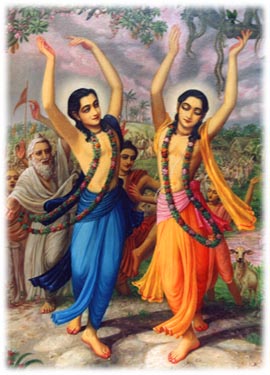
 Bhaktivedanta Swami Eco Village in Vraj, 15 kilometers from the Krishna Balarama Mandir in Vrindavan. It is close to village of Raul, North off the Delhi Mathura Road on the opposite side of the highway from the temple.
Bhaktivedanta Swami Eco Village in Vraj, 15 kilometers from the Krishna Balarama Mandir in Vrindavan. It is close to village of Raul, North off the Delhi Mathura Road on the opposite side of the highway from the temple. 
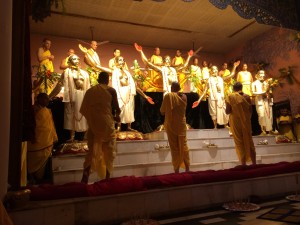
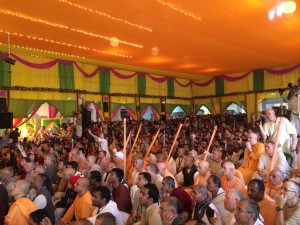
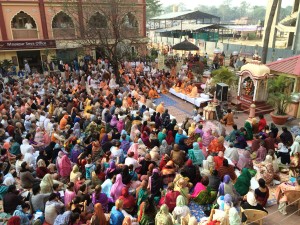
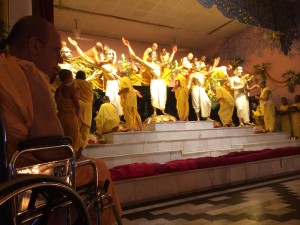
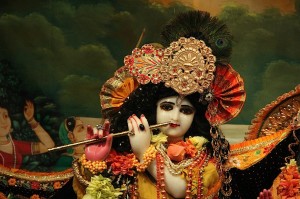






 “May our minds be attached to the lotus feet of your Lord Kṛṣṇa, may our tongues chant His holy names, and may our bodies lie prostrate before Him (CC Ādi 6.60)
“May our minds be attached to the lotus feet of your Lord Kṛṣṇa, may our tongues chant His holy names, and may our bodies lie prostrate before Him (CC Ādi 6.60)  An other elevated soul declares the renouncing of this material world and his complete dependance from Lord Shri Krishna's mercy for ever!
An other elevated soul declares the renouncing of this material world and his complete dependance from Lord Shri Krishna's mercy for ever!  Photos by Indradyumna Swami: The first thing I did today was walk around Vrindavan. It was so nice to see again the people and places that have become familiar to me over the years. Though I often go on parikrama it always feels like the 'first time,' due to Vrindavan's being a transcendental abode. I took my trusty camera to share the glories of Vrindavan with all of you!
Photos by Indradyumna Swami: The first thing I did today was walk around Vrindavan. It was so nice to see again the people and places that have become familiar to me over the years. Though I often go on parikrama it always feels like the 'first time,' due to Vrindavan's being a transcendental abode. I took my trusty camera to share the glories of Vrindavan with all of you!  Sivarama Swami awarded yesterday the entrance of the sannyasa order for Badrinarayan prabhu now known as Badrinarayana dasa Goswami at Sri Mayapura Dhama! Badrinarayan Dasa Goswami’s commitment to the GBC is lengthy, spanning twenty-four years, and he genuinely appreciates his peers as wonderful, kind, intelligent, powerful and humble members of that body, who take on the weight of service and responsibility for the whole society. (In the photo Badrinarayan Dasa Goswami before taking sannyasa)
Sivarama Swami awarded yesterday the entrance of the sannyasa order for Badrinarayan prabhu now known as Badrinarayana dasa Goswami at Sri Mayapura Dhama! Badrinarayan Dasa Goswami’s commitment to the GBC is lengthy, spanning twenty-four years, and he genuinely appreciates his peers as wonderful, kind, intelligent, powerful and humble members of that body, who take on the weight of service and responsibility for the whole society. (In the photo Badrinarayan Dasa Goswami before taking sannyasa) 
